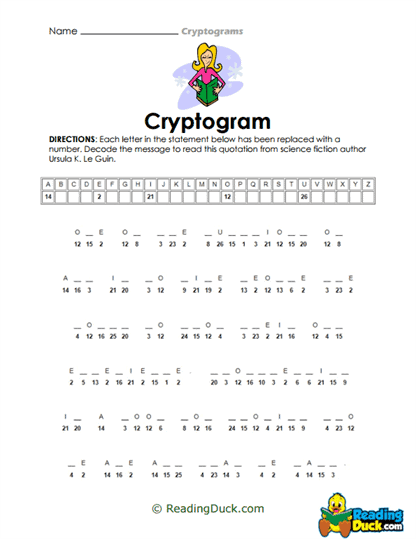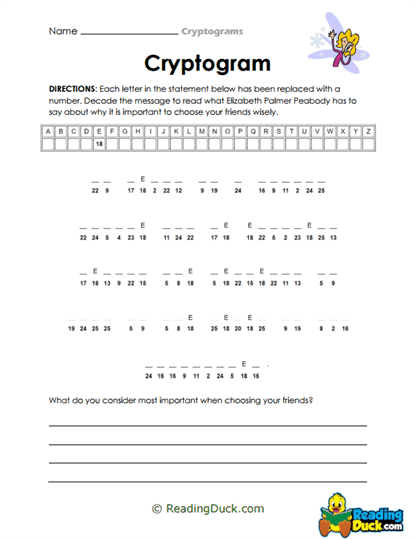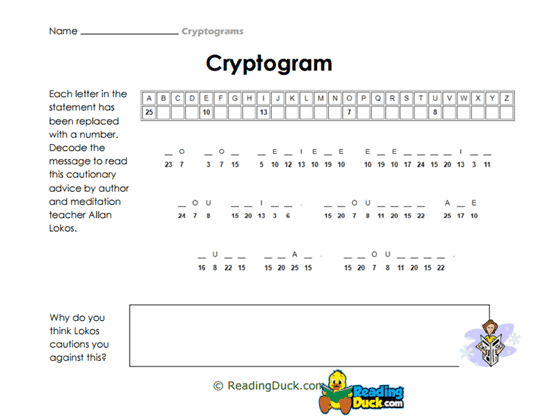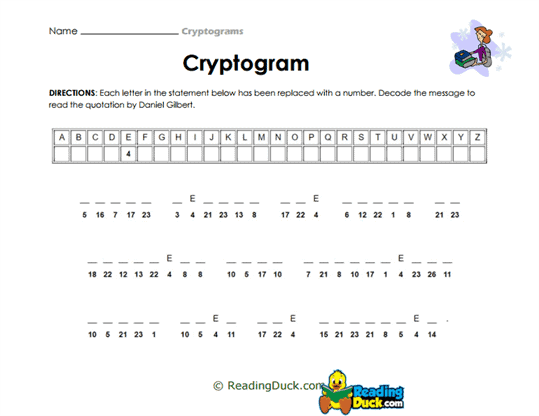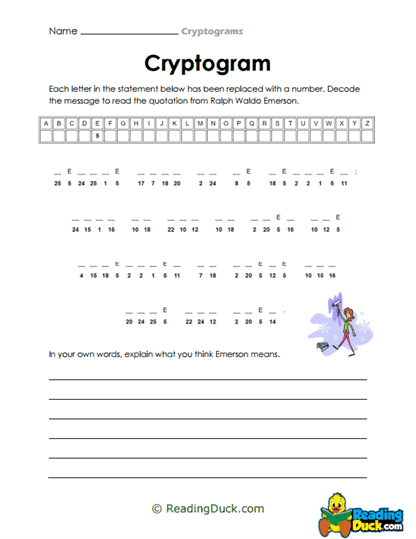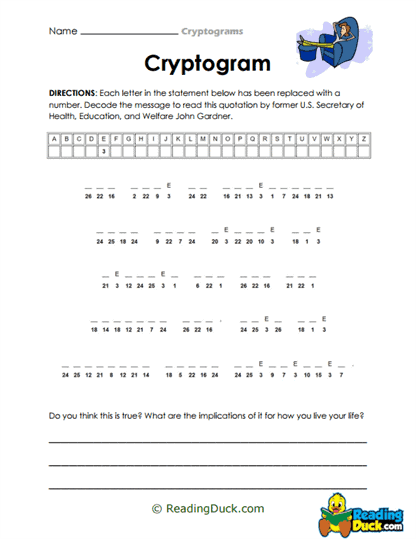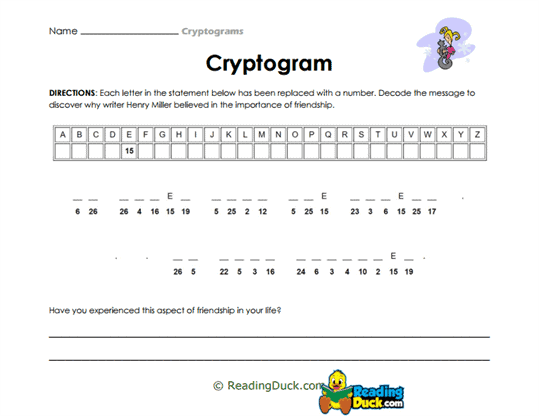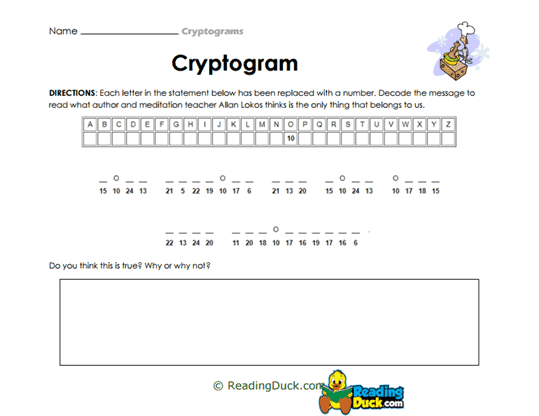Cryptograms Worksheets
About Our Cryptogram Worksheets
Our Cryptogram Worksheets offer a fun and challenging way for students to strengthen their vocabulary and language comprehension. Cryptograms are puzzles where students must decode a hidden message by replacing coded letters with the correct ones. These puzzles encourage students to think critically, enhance their problem-solving skills, and, most importantly, improve their understanding of words and language structures.
Available in PDF format, these worksheets are easy to download, print, and use across a range of learning environments. Each worksheet includes a downloadable answer key to make grading and review simple and efficient for teachers, parents, or tutors. By engaging with cryptograms, students develop stronger vocabulary skills while enjoying an entertaining learning experience that stimulates both their minds and language abilities.
Decoding Language: A Deep Dive into Cryptogram Puzzles
Cryptograms introduce students to the concept of code-breaking, where letters in a sentence or phrase are substituted with other letters. The goal is to decode the message by figuring out which letter in the cipher corresponds to the actual letter in the hidden word. This process requires a sharp understanding of language patterns, vocabulary, and word structure.
When explaining cryptograms for the first time, it’s helpful to walk through the basic concept:
- Coded Messages: Each cryptogram presents a sentence or phrase where letters have been replaced by other letters or symbols. For instance, in the code, A = B, B = C, and so on. The student must decipher the real letters.
- Letter Frequency: Certain letters, such as E, T, and A, appear frequently in English, which provides useful clues. Recognizing patterns like common letter pairs (such as TH or LL) can help students crack the code faster.
- Word Length and Structure: Cryptograms often challenge students to identify common word structures. For example, a one-letter word is likely to be A or I, while two-letter words could be IT, AN, or ON.
For example, students might decode a cryptogram where the ciphered message “ZIV ZMBG” becomes “THE CAT” when properly decoded. By recognizing letter patterns and experimenting with different combinations, students sharpen their understanding of how letters and words function together in the English language. This analytical process not only enhances problem-solving skills but also deepens students' knowledge of vocabulary and sentence structure.
Vocabulary Building Through Cryptograms
Cryptograms provide a unique way to enhance vocabulary by encouraging students to actively engage with word patterns and letter combinations. By solving cryptograms, students are exposed to new words, sentence structures, and vocabulary in an entertaining and engaging format. The Cryptograms Worksheets offer several key benefits to vocabulary development:
- Word Recognition: Decoding cryptograms requires students to identify common words based on letter placement, frequency, and context. As students work through these puzzles, they naturally expand their word recognition abilities.
- Spelling Reinforcement: Because cryptograms demand accurate decoding, students must focus on correct spelling. This helps reinforce proper spelling rules and strengthens their overall language accuracy.
- Contextual Learning: Cryptograms often reveal phrases or sentences that introduce students to new vocabulary in context. This approach ensures that students not only learn new words but also understand their meaning and use within a sentence.
For instance, if a cryptogram reveals a sentence such as, “An apple a day keeps the doctor away,” students will not only decode the individual words but also understand the meaning of the phrase. As they solve more cryptograms, they naturally build a broader and deeper vocabulary while developing the cognitive skills needed to decode unfamiliar words in the future.
Versatile Use in Learning Environments
Our Cryptograms Worksheets are designed for flexible use, making them suitable for a variety of educational settings. Whether in the classroom, during homework assignments, or as part of independent study, cryptograms provide an engaging and challenging way to reinforce vocabulary skills.
- Classroom Activities: Teachers can use cryptogram puzzles as a warm-up activity or a fun challenge to wrap up a vocabulary lesson. Cryptograms encourage collaboration, allowing students to work together to decode messages, fostering teamwork while reinforcing word comprehension.
- Homework Assignments: Cryptograms are perfect for assigning as homework, providing students with an opportunity to practice their vocabulary skills at home. This independent work helps reinforce learning in a way that feels more like a game than a traditional homework task.
- Independent Study: Students looking to expand their vocabulary independently will find cryptograms to be an enjoyable and rewarding tool. The PDF format allows for easy downloading and printing, making these worksheets accessible for students to practice on their own.
The inclusion of answer keys ensures that students can check their work, while teachers and parents can provide quick feedback. This versatility makes cryptograms an effective tool for vocabulary building in any learning environment, from formal classroom settings to at-home study sessions.
Practical Applications and Everyday Importance
Mastering vocabulary through cryptograms has many real-world applications, both academically and practically. Understanding language patterns, sentence structures, and how words fit together is crucial for effective communication in everyday life. Whether students are reading for pleasure, writing essays, or engaging in conversations, having a strong vocabulary enables them to express themselves more clearly and accurately.
- Improved Reading Skills: Decoding cryptograms enhances reading comprehension by familiarizing students with word patterns and sentence structures. This improved understanding of language helps them better comprehend texts in various genres, from novels to academic articles.
- Effective Writing: A well-developed vocabulary allows students to write more fluently and with greater precision. By solving cryptograms, students encounter new words and phrases that they can later incorporate into their own writing, making their essays, stories, and reports more engaging.
- Problem-Solving in Everyday Communication: Cryptogram puzzles strengthen students' problem-solving abilities by teaching them to approach challenges with patience and creativity. These skills are transferrable to real-world communication scenarios, such as deciphering unclear instructions or interpreting nuanced language.
Additionally, cryptogram puzzles can be used as a way to introduce students to thematic vocabulary. For example, puzzles might include vocabulary related to specific topics like nature, history, or technology, allowing students to become familiar with subject-specific language in a fun and engaging manner.
Cryptograms and Test Preparation
Cryptograms not only develop vocabulary skills but also prepare students for standardized tests like the SAT, ACT, and TOEFL, where a strong understanding of vocabulary, word structure, and contextual clues is essential. These worksheets can play a critical role in helping students sharpen the skills needed to succeed on such exams.
- Vocabulary Development: Many standardized tests require students to demonstrate a solid understanding of vocabulary. Cryptograms encourage students to practice recognizing and decoding words, helping them become more familiar with vocabulary that could appear on these exams.
- Critical Thinking: Decoding cryptograms strengthens logical reasoning and critical thinking skills, both of which are essential for approaching vocabulary questions on standardized tests.
- Reading Comprehension: Many tests include sections that assess a student's ability to understand and interpret texts. By practicing cryptograms, students develop a stronger grasp of sentence structure and context, improving their reading comprehension.
By consistently engaging with cryptogram puzzles, students will be better prepared to tackle the vocabulary and language sections of standardized tests with confidence.
Building Language Skills Through Cryptograms
Our Cryptograms Worksheets provide a dynamic and engaging way for students to build their vocabulary, improve their language comprehension, and strengthen their critical thinking skills. Available in PDF format, these worksheets are easy to download, print, and use in a wide range of educational settings, from classrooms to independent study.
Solving cryptograms encourages students to think critically about word patterns, context, and spelling, while also providing a fun challenge that makes learning feel like a game. Whether preparing for standardized tests or simply aiming to expand their vocabulary, students can benefit from the cognitive and linguistic skills gained through these worksheets.
By decoding cryptograms regularly, students develop a stronger understanding of how words function within sentences, improving their overall language proficiency and preparing them for success in both academic and real-world communication. Cryptograms offer a unique way to practice vocabulary, turning learning into an enjoyable and rewarding experience.
